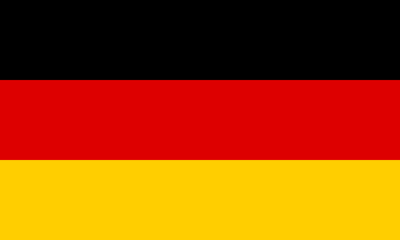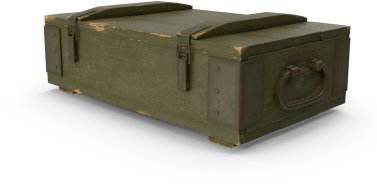On April 10th movement by the 5th Infantry Regiment began toward an assembly area in the neighbourhood of Herbartsdorf. By the morning of the next day arrangements had been completed for an attack on the city of Coburg with the support of the Combat Command B of the 11th Armored Division. Resistance along the outskirts of the city stiffened as the enemy employed aircraft and brought mortar fire into play.
As the troops deployed for the assault, with preparations for an artillery barrage completed, word was received that the city wished to negotiate surrender. The regimental commander of the 5th Infantry Regiment, and the commanding officer of Combat Team B met with the Coburg representatives, terms were arranged, and the city occupied. A screening of the area unearthed a number of prisoners, while the ambush of a patrol in the neighbouring village of Sulzdorf resulted in the smashing of that village by artillery fire.
 Shattered buildings show the pounding received by the railyard at Fulda
Shattered buildings show the pounding received by the railyard at Fulda
When compared with the villages and towns through which the division had marched since leaving Fulda a week earlier, Coburg was a metropolis, and a happy hunting ground for GI’s bent on making additions to individual war trophy collections. Many a citizen enroute to the contraband collecting station, in response to the burgomeister's announcement, found it possible to relieve themselves of their burdens without making the complete trip. Enterprising doughs were more than willing to assume the responsibility of delivering the cameras, the knives, the ornamental sabres, and the efficient, highly prized German small arms. The question of a receipt for confiscated materials that were to be temporarily placed in safe keeping was handled with greater speed than was possible at the established collecting point.
A centrally located wine cellar experienced an astounding rush of business, all presumably on credit, for the proprietor was nowhere on the premises.
 Prisoners of war being marched into the city square at Coburg
Prisoners of war being marched into the city square at Coburg
In a tiny bierstube a block and a half off the city square, the owner and two women members of his family dispensed beer and wine across the bar at so furious a rate that it was impossible to ring the sales upon the cash register. Even then, immediate satisfaction of the demand would not have been possible had not willing infantrymen stepped behind the counter and accelerated the flow to the eager customers.
During the course of the action in which the 5th Infantry Regiment was engaged, the 66th Infantry Regiment had been sweeping forward in its zone of operation against scattered enemy resistance and after seizing Hildburghausen continued its advance to Bockstadt and Kloster Veilsdorf. The Second Battalion of the 66th Infantry Regiment assisted elements of the 11th Armored Division in the capture of Neustadt and cleared the Neustadt-Coburg road of numerous lightly defended roadblocks. The regiment continued its mission of maintaining contact with the 26th Infantry Division and protecting the division to the north flank by covering the gap which developed from the more rapid advance of the 71st Infantry Division.
The 14th Infantry Regiment, still operating along the sivision south boundary, continued the mission of protecting the south flank of the XII Corps by sideslipping eastward along' this flank as the drive continued. In addition, the Third Battalion executed the mission of protecting the Corps command post at Meiningen.
From the time of the Rhine crossing, and following the early delay brought about by the fighting with the 6th SS Mountain Division Nord, the division had moved an average of ten to fifteen miles daily conducting a meticulous search of all wooded areas, and towns, and villages in its path. Large numbers of prisoners of war were taken, many of whom were soldiers who had dressed in civilian clothes to escape capture.
The years of preparation for war had given the German ample time to devise a multitude of uniform colours and combinations. Some of them, such as Goring's much photographed and bemedaled white covering, were products that would put the costumes of a stateside comic opera to shame.
A wireman checking a communications line along a railroad during one of those days of sweeping and cross-country hops, came upon a resplendently outfitted individual. Aware of the variance in uniform practiced by the enemy he took no chances, but proceeded to march his captive toward the nearest village with an M-1 muzzle levelled at the small of the prisoner's back. With the unwilling prisoner protesting volubly each step of the way, the procession of two reached the edge of town. Here the language difference was amended by a chance meeting with a German speaking dough from Intelligence. For the first time the wireman knew the nature of his prize, a railroad conductor.
 A familiar sight to the 71st Infantry Division was this type of roadblock
A familiar sight to the 71st Infantry Division was this type of roadblock
Artillery operations during this period had necessarily been restricted because of the speed of the advance. Artillery fire was generally limited to targets of opportunity.
On April 12th the 71st Infantry Division and the 11th Armored Division were poised in readiness to continue the attack to the east and southeast with the mission of seizing Kulmbach, and Bayreuth.
The 11th Armored Division began its advance toward its objective with the 71st Infantry Division following closely on its heels, and at the same time continuing its mission of maintaining protection of the Corps' south flank.
The advance continued, three regiments abreast, with the 14th Infantry Regiment in the center of the zone. Each regiment motorized one battalion in order to maintain close contact with the 11th Armored, while the other battalions were ordered to continue sweeping operations following along the path of the armor and motorized infantry. By the end of the day, April 13th, elements of infantry and armor were located above Bayreuth.
 Scenes at airport near Bayreuth
Scenes at airport near Bayreuth
The next morning, the Commanding General of the XII Corps, in a telephone call to the Commanding General of the 71st Infantry Division, directed him to launch an attack against the city without delay. Reconnaissance elements of the 11th Armored, and the 14th Armored Divisions had entered the city's outskirts and were engaged in a fierce fire fight with its defenders.
The Commanding General of the 71st Infantry Division issued an order constituting Combat Team 14, and to it attached the 1st Battalion of the 5th Infantry Regiment for this operation. Early that afternoon the 14th Combat Team passed through the armor and launched its attack upon the city.
By 0900pm the 1st Battalion of the 14th Infantry Regiment held the western portion of the city north of the Main River, while the 1st Battalion of the 5th Infantry Regiment held the western portion of the city south of the river.
The entrance into the city was fiercely contested by enemy troops and was gained only after overcoming many strongly defended positions and smothering the sniper fire coming from the buildings.
Darkness had fallen before the entire strength of the 1st Battalion of the 5th Infantry Regiment reached the centre of their captured sector. With outposts manned, the battalion sought its billets and hurried about its preparations for resting throughout the remainder of the night. The battalion command post was set up in a hotel while the line company personnel not occupied with guard and outpost duty were bedded down in convenient buildings adjacent to the hotel.
Sometime later those still awake heard the silence of the night broken by the sound of sporadic anti-aircraft fire. A throbbing plane motor swelled and faded in the distance. The switchboard operator at the battalion command post listened to the conversation of a phone call and learned that a German plane, strafing an outpost, had been driven off by defensive fire.
Quietness reigned again. The operator dozed at his board as the moments slipped by. Then the silence was shattered by a sudden roaring of an engine, the clatter of machine guns, and the bursting of anti-personnel bombs. A sneak approach had brought an enemy plane hurtling over the area. His missile exploded, a near miss, and shrapnel burst through the street in front of the command post, shattering the windows, wounding some, and blasting the sleep of many. With the injured cared for, and communications restored, sleep again became the order of the moment.
Mopping up operations continued in the in the city for the following two days and by nightfall of the 16th of April it had been securely and completely occupied. Over 750 prisoners, including a German Major-General, were captured. Unknown numbers had been killed or driven eastward.
In the neighbourhood of Marktschorgast, which fell to the 3rd Battalion of the 66th Infantry Regiment, a couple of Priva First-Class's sought a bit of recreation in a jaunt about the countryside on a Jerry motorcycle and attached sidecar.
Incidental meetings with individual enemy soldiers resulted in a disarming of each Jerry until the sidecar's capacity for both man and arms were cruelly taxed. The weapons were thrown into the bushes.
Moments later the duo drew fire from a group of considerable size. The sidecar occupant reached for his M-1 only to discover that it had been discarded with the tossed aside Jerry weapons. Further sight-seeing was immediately deemed inadvisable, and the operation plan changed to a hasty retreat to the security of friendly lines.
 This line of trenchworks at Coburg was abandoned by the Gemans in the face of heavy shelling by the division on Bayreuth.
This line of trenchworks at Coburg was abandoned by the Gemans in the face of heavy shelling by the division on Bayreuth.
The 2nd and 3rd Battalions of the 66th Infantry Regiment, advancing down the Nurnberg- Bayreuth autobahn, ran into enemy mortar and bazooka fire in the vicinity of Deps. Deploying, and pressing an attack through a heavily wooded area, the attacking forces came upon a large airport and aeronautical school, defended by the Luftwaffe and Wehrmacht soldiers. In the face of small arms, mortar, bazooka, and anti-aircraft weapons fire, the attack was carried through resulting in a rout of the defenders, and the capture of 520 of the enemy. The airfield was secured, and the retreating enemy pursued as they withdrew into the nearby towns of Deps and Benk.
The capture of Bayreuth, and the sweeping operations of the other elements of the Division brought the 71st Infantry Division up to the Army Restraining Line by the 15th of April. Here the unit assumed a defensive role while reconnaissance was carried out to the east of the line. Both, April 15th and 16th were spent in reorganization and readjustment of positions.
Now, when you had a chance to look at a map, you wondered just how much longer Jerry was going to go on with this business. Coburg and Bayreuth were behind the "Red Circle", who had come all the way from France along the ground, walking and riding. You wondered how much further you would have to walk chasing Germans.
When you heard the story of the "Big Picture" with the Russians sitting on the eastern doorstep to Berlin, with the 1st and 9th Armies deep in northern Germany, and the 7th slashing in on your right, you cussed to yourself wondering how anyone could be so simple as to not see defeat immediately in the offing.
Written by Pierre Fallet

















